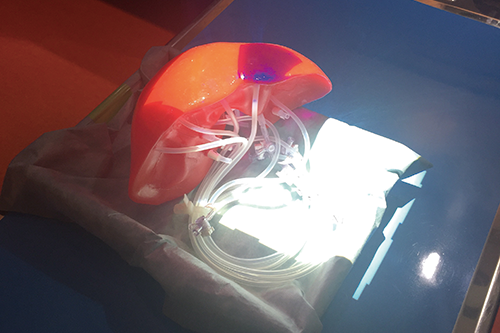Global Successes Safer, More Accurate Surgery: The Development of a New Medical Imaging Projection System
ACCELERATION TRANSFORMATIVE RESEARCH FOR MEDICAL INNOVATION (ACT-M)

MIPS projecting onto an artificial liver.
The lesion to be surgically removed is highlighted.
At AMED, we strive to promote innovative technologies that respond to current, pressing medical needs, and in FY2015, we initiated ACT-M: Acceleration Transformative Research for Medical Innovation.
An industry-academia collaboration, ACT-M encourages open innovation and venture development in a range of fields, including the development of medicine, medical treatment and medical equipment.
As part of the program, our research led to the development of a new type of medical equipment: a Medical Imaging Projection System (MIPS). The real-time navigation system – a world’s first – combines near-infrared fluorescence-guided surgery with projection mapping technology to significantly enhance the safety and accuracy of hepatectomy procedures.
While near-infrared fluorescence color systems are useful, existing methods require a handheld camera and monitor. This means surgeons must frequently shift their view from the patient’s organs to the monitor to confirm fluorescent images, while surgical lamps must regularly be switched on and off to avoid complications.
The utilization of projection mapping helps to overcome such problems, and allows surgeons to fully focus on the patient’s organs. It eliminates the need for display monitors, and projects accurate guidelines directly onto the operating field. As a result, accuracy greatly improves while the surgeon carries less of a burden.
A clinical study conducted at Kyoto University Hospital compared hepatectomy on patients with and without the use of MIPS. Results showed the use of MIPS had a tendency to increase the accuracy of dissections. In addition, MIPS showed high sentinel lymph node identification rates in breast cancer surgery, confirming the effectiveness of real-time navigation.
Moving forward, we will continue to develop MIPS in order to enhance its capabilities and increase the accuracy of surgery. This way, we aim to further reduce the burden on surgeons and ease the postoperative recovery of patients.
 Concept
Concept
The development of a new Medical Imaging Projection System (MIPS) with near-infrared fluorescence, for use in real-time navigation surgery. For safer, more accurate hepatectomy procedures.
 Progress
Progress
Since introducing our first-generation equipment with a class-one pharmaceutical approval rating in FY2015, we have come a long way on our journey for medical innovation. In FY2016, we recognized the advantages of MIPS from the results of a clinical study, and in FY2017, we made further enhancements to the equipment and began developing second-generation equipment. In FY2018, we plan to apply for a class-two pharmaceutical approval rating.
 Collaborators
Collaborators
Panasonic Corporation; Kyoto University Hospital; MITAKA KOHKI CO., LTD.
Last updated 09/20/18

